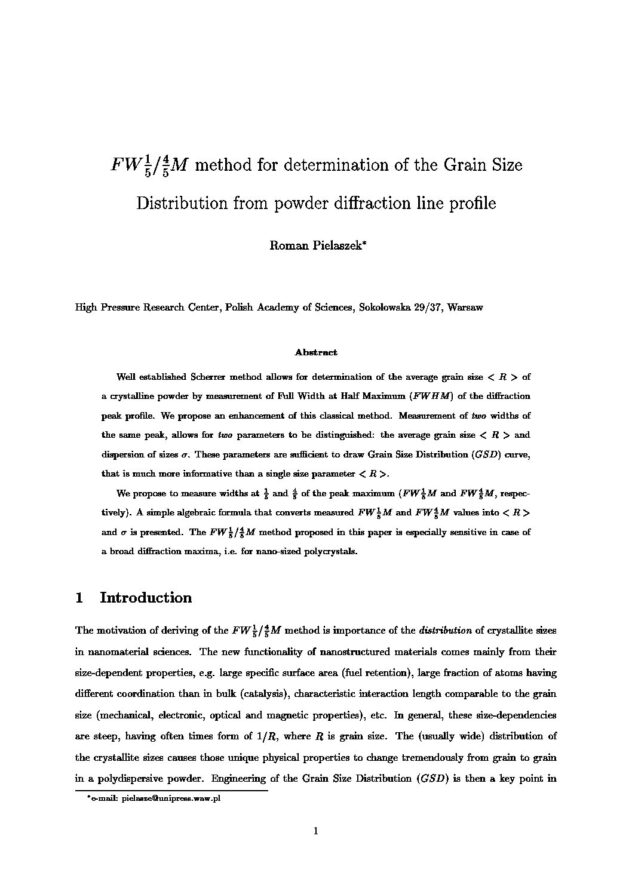FW 1/5-4/5 M method for determination of the Grain Size Distribution from powder diffraction line profile
Roman Pielaszek
High Pressure Research Center, Polish Academy of Sciences, Sokolowska 29/37, Warsaw
Abstract
Well established Scherrer method allows for determination of the average grain size
We propose to measure widths at 1/5 and 4/5 of the peak maximum ( FW1/5M and FW4/5M , respectively). A simple algebraic formula that converts measured FW1/5M and FW4/5M values into
1 Introduction
The motivation of deriving of the FW1/5M-4/5M method is importance of the distribution of crystallite sizes in nanomaterial sciences. The new functionality of nanostructured materials comes mainly from their size-dependent properties, e.g. large specific surface area (fuel retention), large fraction of atoms having different coordination than in bulk (catalysis), characteristic interaction length comparable to the grain size (mechanical, electronic, optical and magnetic properties), etc. In general, these size-dependencies are steep, having often times form of 1/R , where R is grain size. The (usually wide) distribution of the crystallite sizes causes those unique physical properties to change tremendously from grain to grain in a polydispersive powder. Engineering of the Grain Size Distribution ( GSD ) is then a key point in design of the new materials, and consequently GSD determination is the fundamental measurement in the nanomaterials science.
The method proposed is meant to be an extension of the Scherrer method for polydispersive powders. Therefore FW1/5M-4/5M procedure can be applied to the same classes of crystalline powders and bears same limitations as the Scherrer method does: it should be used for materials where only size broadening of the diffraction peaks appears. Other effects, e.g. lattice strain, stacking faults, K doublets, overlapping peaks, etc. would artificially decrease size readings.
The method proposed has been derived from analytical expression for diffraction line profile for polydispersive crystalline powder (see below). Similar expression for monodispersive powders with cubical grains has been given by Wilson, then substantial effort has been made to derive peak profile formula for various crystalline shapes. Recently, there were published also expressions for polydispersive powders with log-normal and Gamma size distributions, however containing special functions, that disallow further analytical investigations.
(…) Please see PDF (…)
6 Concluding remarks
The FW1/5M-4/5M method presented has been thought as an extension of the classical Scherrer method. It derives both: the mean and the dispersion of the Grain Size Distribution. We have to state, that quality of determination of the dispersion parameter is very sensitive to the diffraction data statistics (level of noise). Therefore, full GSD determination requires longer data acquisition times and/or stronger radiation sources that those used for “standard” powder diffraction measurements.
7 Acknowledgments
Author would like to thank to Stanislaw Gierlotka, Ryszard Kutner, Joanna Kutner-Pielaszek, Witold Lojkowski, Henryk Marciniak, Wladek Minor, Bogdan Palosz and acknowledge support of Polish State Committee for Scientific Research (KBN grants 7/T08A/036/18 and 7/T08A/030/19).

